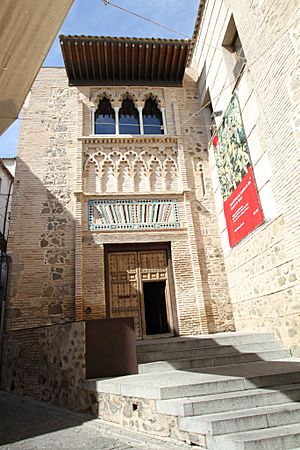Convento de la Madre de Dios, Toledo facts for kids
The Convento de la Madre de Dios (which means Convent of the Mother of God) is an old religious building in Toledo, Spain. It was started by Dominican nuns way back in the late 1400s. Two sisters, Leonor and María de Silva, whose father was the Count of Cifuentes, founded it.
Over time, this special place changed its purpose. It was a quiet monastery for nuns, then a barracks for the Guardia Civil (like a police force). Today, it's part of the University of Castilla-La Mancha. Students now learn about law and social sciences here.
Contents
History of the Convent
The convent grew a lot from the late 1400s to the mid-1600s. It became a typical convent with buildings built around courtyards.
Changes Over Time
After the 1600s, the building started to get old and damaged. This continued through the 1700s and especially the 1800s. Some parts of the convent were even lost.
In the 1900s, there were some small repairs. But the biggest change happened when the University of Castilla-La Mancha bought it. They wanted to use it to make their San Pedro Mártir university center bigger.
Discoveries During Restoration
When the university was fixing up the convent, they did a lot of digging. This was especially true in the area where the nuns used to have their garden. They found old things from different times, like Roman times and the Middle Ages.
One very important discovery was a special doorway from the 1300s. This doorway is called a Mudéjar portal. It faces Father Juan de Mariana Square. It was probably part of a fancy house before the convent was built.
The Mudéjar Doorway
This amazing doorway has three main parts:
- The bottom part has a door with a stone beam above it. Above the beam, there are rows of bricks mixed with colorful tiles. These tiles are white, green, and black.
- The middle part has a series of arches that cross over each other.
- The top part has a large window with three more arches. These arches are supported by marble columns.
Inside the Convent Today
Where the nuns' garden used to be, there is now a courtyard. A new building was also added here. This new building helps make the San Pedro Mártir library and its offices bigger.
The main courtyard, called the cloister, was changed over the years. It used to have one floor, but now it has two. You can see cool writing on the walls of the lower cloister. There are also wooden beams supported by special carved pieces.
The upper cloister has many classrooms and offices. It has big glass windows that were added during the latest repairs. You can also see special octagonal (eight-sided) pillars in the corners of the upper part of the cloister.
The church is located on the eastern side of the cloister. The choir (where the nuns sang) and the church changed places in the 1800s. This happened because the original church roof was lost. The choir then became the new church. Today, this space is used as a classroom.
The building still has its original cloister and the main part of the church. The church is now called the Aula Magna, which means "Great Hall." It's used for big events. Outside, the repairs showed the only Mudéjar portal in Toledo that was part of a noble house.
Today, about 4,000 students come to this complex every day. They study subjects like Law, Business Management, and Public Administration.
See also
- Catholic Church in Spain
 In Spanish: Convento de la Madre de Dios (Toledo) para niños
In Spanish: Convento de la Madre de Dios (Toledo) para niños


